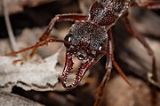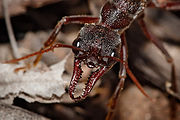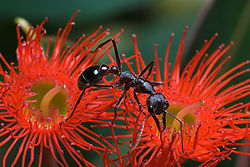
Myrmecia
Encyclopedia
Myrmecia, often called bulldog ants, bull ants, inch ants, sergeant ants, jumper ants or jack-jumpers
(although jack jumper only applies to members of the M. pilosula species group), is a genus of ant
s. Bull ants can grow to over 40 mm (1.6 in) in length, with the smallest species 15 mm (0.590551181102362 in) long. Almost all of the approximately 90 species are endemic
to Australia
, with the single exception of Myrmecia apicalis from New Caledonia
, where it is rare.

 Bull ants eat small insects, honeydew
Bull ants eat small insects, honeydew
(a sweet, sticky liquid found on leaves, deposited from various insects), seeds, fruit, fungi, gums, and nectar. The adult ants mainly eat nectar and honeydew, but the ant larvae are carnivore
s that eat small insects brought back to them by hunting worker ants. The workers can also regurgitate food back in the nest so other ants can consume it.
Foes of bull ants are the black ant
s, which despite being much smaller, use their much greater numbers to overwhelm bull ant colonies.
's major work, The World as Will and Representation
, as a paradigmatic example of strife and constant destruction endemic to the "will to live".
"But the bulldog-ant of Australia affords us the most extraordinary example of this kind; for if it is cut in two, a battle begins between the head and the tail. The head seizes the tail in its teeth, and the tail defends itself bravely by stinging the head: the battle may last for half an hour, until they die or are dragged away by other ants. This contest takes place every time the experiment is tried."

Jack jumper ant
The jack jumper ant, hopper ant, jumper ant or jumping jack, Myrmecia pilosula, is a species of bull ant that is native to Australia...
(although jack jumper only applies to members of the M. pilosula species group), is a genus of ant
Ant
Ants are social insects of the family Formicidae and, along with the related wasps and bees, belong to the order Hymenoptera. Ants evolved from wasp-like ancestors in the mid-Cretaceous period between 110 and 130 million years ago and diversified after the rise of flowering plants. More than...
s. Bull ants can grow to over 40 mm (1.6 in) in length, with the smallest species 15 mm (0.590551181102362 in) long. Almost all of the approximately 90 species are endemic
Endemic (ecology)
Endemism is the ecological state of being unique to a defined geographic location, such as an island, nation or other defined zone, or habitat type; organisms that are indigenous to a place are not endemic to it if they are also found elsewhere. For example, all species of lemur are endemic to the...
to Australia
Australia
Australia , officially the Commonwealth of Australia, is a country in the Southern Hemisphere comprising the mainland of the Australian continent, the island of Tasmania, and numerous smaller islands in the Indian and Pacific Oceans. It is the world's sixth-largest country by total area...
, with the single exception of Myrmecia apicalis from New Caledonia
New Caledonia
New Caledonia is a special collectivity of France located in the southwest Pacific Ocean, east of Australia and about from Metropolitan France. The archipelago, part of the Melanesia subregion, includes the main island of Grande Terre, the Loyalty Islands, the Belep archipelago, the Isle of...
, where it is rare.
Biology
These ants are well-known in Australia for their aggressive behaviour and powerful stings. The venom of these ants has the potential to induce anaphylactic shock in allergic sting victims. As with most severe allergic reactions, if left untreated the reaction may be lethal. These large, alert ants have characteristic large eyes and long, slender mandibles. They have superior vision, able to track and even follow intruders from a distance of 1 metre. Myrmecia is one of several ant genera which possess gamergates, female worker ants which are able to mate and reproduce, thus sustaining the colony after the loss of the queen. A colony of Myrmecia pyriformis without queen was collected in 1998 and kept in captivity, during which time the gamergates produced viable workers for three years.Diet


Honeydew (secretion)
Honeydew is a sugar-rich sticky liquid, secreted by aphids and some scale insects as they feed on plant sap. When their mouthpart penetrates the phloem, the sugary, high-pressure liquid is forced out of the gut's terminal opening. Honeydew is particularly common as a secretion in the Hemipteran...
(a sweet, sticky liquid found on leaves, deposited from various insects), seeds, fruit, fungi, gums, and nectar. The adult ants mainly eat nectar and honeydew, but the ant larvae are carnivore
Carnivore
A carnivore meaning 'meat eater' is an organism that derives its energy and nutrient requirements from a diet consisting mainly or exclusively of animal tissue, whether through predation or scavenging...
s that eat small insects brought back to them by hunting worker ants. The workers can also regurgitate food back in the nest so other ants can consume it.
Foes of bull ants are the black ant
Black ant
Black ant is a term used for eusocial insects of the family Formicidae that are black in color. It has been used to describe many ants, including, but not limited to:*The Black carpenter ant...
s, which despite being much smaller, use their much greater numbers to overwhelm bull ant colonies.
Philosophy
The bull ant famously appears in the philosopher Arthur SchopenhauerArthur Schopenhauer
Arthur Schopenhauer was a German philosopher known for his pessimism and philosophical clarity. At age 25, he published his doctoral dissertation, On the Fourfold Root of the Principle of Sufficient Reason, which examined the four separate manifestations of reason in the phenomenal...
's major work, The World as Will and Representation
The World as Will and Representation
The World as Will and Representation is the central work of the German philosopher Arthur Schopenhauer. The first edition was published in December 1818, and the second expanded edition in 1844. In 1948, an abridged version was edited by Thomas Mann....
, as a paradigmatic example of strife and constant destruction endemic to the "will to live".
"But the bulldog-ant of Australia affords us the most extraordinary example of this kind; for if it is cut in two, a battle begins between the head and the tail. The head seizes the tail in its teeth, and the tail defends itself bravely by stinging the head: the battle may last for half an hour, until they die or are dragged away by other ants. This contest takes place every time the experiment is tried."
Species

|
Myrmecia inquilina Myrmecia inquilina is a species of insect in family Formicidae. It is endemic to Australia.-Source:* Social Insects Specialist Group 1996. . Downloaded on 10 August 2007.... Douglas & Brown, 1959 Myrmecia nigriceps Myrmecia nigriceps is a species of bull ant that is native to Australia.... Mayr, 1862 Myrmecia pavida Myrmecia pavida is a bull ant species which live in Australia. Workers and Queens averagely are around . This species can be found throughout all of Western Australia, where their head and thorax and reddish, and the abdomen is black. Myrmecia pavida, like all of the other Myrmecia species, has... Clark, 1951 |

